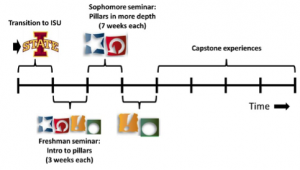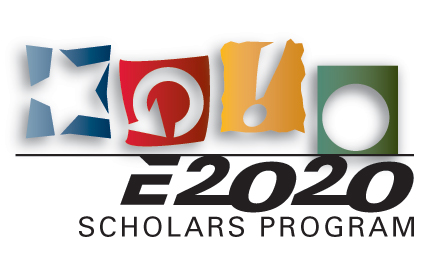Overview
Four E2020 outcomes were emphasized in Iowa State’s program: leadership, global awareness and understanding, systems thinking, and innovation and entrepreneurship. These outcomes, or pillars, were integrated into curricular and co-curricular activities. The four pillar areas were introduced in a one-semester first-year seminar and reinforced in a two-semester second-year seminar. These seminars supplement the regular program of study for engineering students.
The figure below illustrates a semester-based timeline for the student experience in the E2020 program over four years, or eight semesters, upon entry into engineering. The graphical icons represent the pillars of the program: star, leadership; arrow, systems thinking; exclamation, innovation; and circle, global awareness.
ENGR 110 and 210
A one-credit seminar course, ENGR 110, was taken by scholars during the second semester of their first year in the program. It introduced students to each of the four pillars over twelve weeks. With three weeks per pillar, the first week introduced the students to knowledge related to the pillar; the second week focused on developing basic skills through an active learning activity; and during the third week, students worked in teams to demonstrate their ability to apply the new knowledge and skills to a real-world problem. Peer mentor sessions were interspersed with the class sessions.
Another one-credit seminar course, ENGR 210, was taken during fall and spring semesters of the second year, and provided more in-depth investigation into the pillars. The fall semester seminar was split into two seven-week periods, one for the leadership pillar and another for systems thinking. The spring semester seminar was split between the innovation and global awareness pillars. A faculty leader for each pillar had developed pillar-specific learning modules and assessment methods.
Pillars
Leadership development emphasized that good leadership may be achieved differently by each leader. One of the primary goals of this pillar was getting students to appreciate various aspects of these main topics: (1) knowing yourself, (2) teamwork, (3) communication, and (4) self-discipline. Additionally, the pillar helped students understand the importance of interpersonal relationships, effective communication, and serving as a member of a team as a leader and/or follower. Read more…
Innovation and entrepreneurship involved key skills and abilities for practicing engineers. One of the primary goals of this pillar was to increase students’ awareness that the skills of an entrepreneur will help them to be better engineers. These skills included: challenging paradigms, leveraging diverse resources, thinking expansively, evaluating multiple solutions, ensuring relevance, and thinking like an entrepreneur. Read more…
Systems thinking has been defined in a number of ways and these aspects were emphasized: viewing a problem broadly and holistically; identifying interdependence and feedback; synthesizing as well as analyzing individual components; and accounting for dynamic (time-varying), nonlinear behavior. Systems thinking activities were designed to prepare students to consider the “big picture”—the interaction of processes within and across disciplines—and work with the unknown, uncertain, or changing information that inevitably accompanies real engineering challenges. Read more…
Global awareness has several possible meanings. In the E2020 project, global awareness was presented as being aware of and respectful of cultural and international differences in needs and values, understanding how regional and cultural differences affect the engineering design process and engineering business enterprise in general, and being able to work effectively with others from different cultures. Read more…


